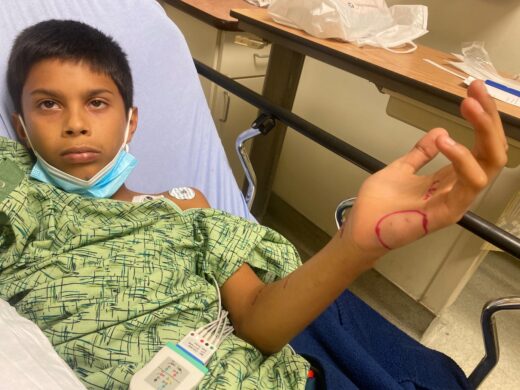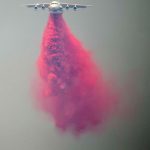
San Diego mother of three Vera Nakova Ortiz had an eventful Labor Day weekend. Her long weekend in the San Jacinto Mountains with her children nearly turned to tragedy when her son Alex was bitten by a rattlesnake outside the house where they were staying. The boy is fine now, and Vera was so impressed with the assistance her family received from local first responders that she wrote a very complimentary letter to the Idyllwild Fire Department, thanking them for their professionalism and compassion above and beyond the call of duty.
The Crier spoke to her and her son by phone this week.
TC: “Had you been to Idyllwild before?”
VNO: “No, this was my first time. The town has a nice blend of culture, entertainment, nature and the Wild West experience. We went downtown, listened to live jazz, got ice cream, went hiking. Even around the house was fun for the kids to explore.”
TC: “How did you find Idyllwild?”
VNO: “I had heard great reviews from friends of mine who live in San Diego. They take their families there. We were very pleased; we stayed in a vintage house with a lot of reminders of the old days.”
TC: “You had three children with you that weekend?”
VNO: “Yes, Daniela 5, Alex 11, and Victoria 13.”
TC: “The 11-year-old was bitten?”
VNO: “Yes, he’s fine now. Children who are used to playing with lizards they need to know the head looks like a lizard’s head, but if you don’t see the rest of the body you need to assume the worst.”
Alex confirmed this: Rattlesnake heads do “look like lizards,” but their bites “are scary and hurt.”
TC: “Did he receive serum?”
VNO: “No, but they assessed him. They took him to the emergency room, and then he was under the supervision of a doctor to understand if he indeed had venom or not, because 25% of all rattlesnake bites don’t have venom. You need to observe the wound and see if, over time, it begins to swell, change color. If it doesn’t, you are one of the lucky ones.”
Vera recalled the moment of panic and the realization that Idyllwild’s location made the emergency more complicated. “I didn’t know there was no hospital there. As soon as I found out (that Alex was bitten) I ran to the neighbors and asked, ‘Where do we go?’ They said, ‘There is no hospital; go the fire department, the paramedics.’ Within minutes of arrival he was in a vehicle to go to Hemet. Before leaving for the hospital, the firefighters gave me the hospital address in case I could not follow the emergency vehicle.
“What was amazing is that the firefighters didn’t just think about him, they thought about the whole family. I had two other children. They proposed to go by the house, let them know what we were doing, where we were. They took them to the firehouse. They set up a bed for them, had TV. They had a firefighters immersion program. The girls felt immersed. Greg Minor, he was in charge of the operation, kept me up to date about what they were doing, let me wish them goodnight, give them the good news about Alexander. So thorough and thoughtful. And to top it all off, Greg had thought about the contingencies; in case there was a fire and he had to deploy, he had made an arrangement for one of the firefighter’s wives to step in. They planned ahead for everything, gave me guidance, gave me a lifeline. If he had been bitten with venom. I would have spent the whole night with him. I had peace of mind that my girls were in a safe place during this time.”
The Crier spoke with Idyllwild Fire Chief Mark LaMont. He said Idyllwild Fire sees snake bites, “two to three times one year, maybe none the next. On the mountain top in general, between us and Anza we do run a fair number.”
About the extended care for Vera’s family during the incident, LaMont said, “We do what we can. If it’s possible, we will go out of our way to make sure people are well taken care of. If it had happened on a night with two structure fires and a medical emergency …” LaMont trailed off as he thought of the really hard days. He explained that fire personnel strive “to lessen the impact of an incident on the people we are serving. If we have the capability we will; it doesn’t mean that we will always be able. We’ve sat dogs overnight, we’ve let people spend a night in the training room. We can’t guarantee it.”
In a 2021 Town Crier article, Loma Linda University Professor of Biology William K. Hayes Ph.D., put the danger in perspective: “If bitten and envenomated, the victim must be transported to a hospital as quickly as feasible. Helicopter transport may be necessary from a remote area if symptoms are alarming. Try to stay calm, but forget about any kind of first aid treatment, as none are effective. Once at the hospital — any of which should have antivenom in stock — you will be given an amazing treatment for the venom: it’s called antivenom. The sooner you get the antivenom, the better. Time is tissue. The venom will cause a lot of pain and suffering as it damages your tissues. It could cause scarring, permanent stiffness or amputation of a digit or limb. It could seriously injure your kidneys. You could die.
“The good news is that you are highly likely to live — though you might wish you were dead. Of the 5,000 to 8,000 venomous snakebites in the U.S. each year, only about five to eight victims will die, so your odds of survival are about 999 out of 1,000. Children and the elderly are at greater risk of permanent injury, which, though uncommon, can happen.”
Hayes also wrote that most snake bite victims (80%) are male, and that inebriation plays a role in many occurrences. So, guys, don’t drink and handle snakes. The U.S. Dept. of Agriculture Snake Safety information (https://www.fs.usda.gov/Internet/FSE_DOCUMENTS/stelprdb5393596.pdf) gives conflicting percentages for the chance of a bite being dry, once reading 25% and then elsewhere 33%. Even a dry bite may result in infection and should be attended by professionals.










